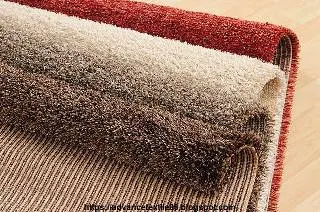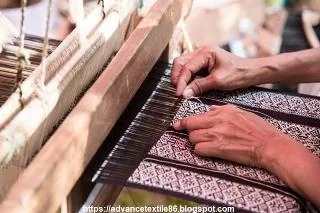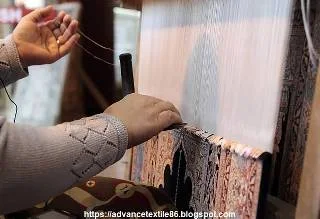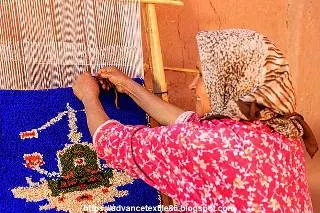Introduction
The word carpet comes from the ancient French
carpite. A conclusion of the word states that the French word comes from the
ancient Italian carpita, meaning infinitive from the verb carpire. The meaning
of the word carpet was changed in the fifteenth century to give the floor. The
word carpet is often interchanged with the word rug. Some sources define a carpet as extending
from wall to wall. Another definition is to consider rugs as low quality or
small size, carpets are often finished.
What is Carpet?
A carpet is a textile floor covering that
consists of an upper layer of pile usually attached to a backing. The pile
was generally made of wool, but since the twentieth century, synthetic fibers
like polypropylene, nylon, or polyester have been used more frequently, as these
fibers are less expensive than wool. The pile generally consists of curved
tufts that are usually heat-treated to maintain their structure. The term
carpet is often used in a context similar to the word rug, but rugs are
generally considered smaller than a room and are not attached to the floor.
History of Carpet
The knotted pile carpet possibly developed in the
Caspian Sea region or the Armenian highlands. Though there is evidence of goats
and sheep are sheared for wool and hair after the 6th millennium, the earliest
surviving pile of carpets dates from the 5th-4th century BC to the Pazyryk
carpet in the Altai Mountains of Siberia in 1949, by Sergei Ivanovich Rudenko.
This colored carpet is 200 x 183 centimeters and framed by a border of
griffins.
Types of Carpet
There are different types of carpet, such as
below-
Woven carpet
The carpet is made of quite a loom-like woven cloth.
The pile can be Plush or Berber. Plush carpet is a spun pile and Berber carpet
is a loop pile. There is a new style of carpet combining two styles called cut
and loop carpeting. Usually, many colored yarns are used and this process is
able to create more complex patterns from predefined designs. This carpet is
usually the most valuable due to the comparatively slow speed of the
manufacturing process. This is very popular in Iran, India, Pakistan, and Arabia.
Knotted carpet
Woven into a carpet weave is a traditional rug. On a
knotted pile carpet, the structural weft threads alternately knit with a
complementary weft that rises to the right corner of the weaving surface. This
supplementary loom was attached to the warp by a three-knot type shag carpet in
the 1970s to form a pile of glass. Oriental rugs and hand knots on carpets are
the most common. Kashmir carpet is also hand-knotted. Pile carpets like flat
carpets can be woven into a loom. Both vertical and horizontal looms have been
used in European and oriental carpet manufacturing. The knitting threads are
set up in the loom frame before the loom starts. A number of weavers can work
together on the same carpet. One row of knots is finished and cut. The knots
are secured with rows of wafers. In woven carpets, the pollen is usually cotton
and the loom is jute.
Embroidered carpet
Unlike woven carpets, embroidered carpets are not made
into a loom. Their pattern is established by applying stitches to the base of
the fabric. The tent stitch and cross stitch are the two most common stitches. Embroidered
carpets were traditionally made at home by royal and aristocratic women, but
there has been some commercial production since the introduction of steel
needles and the improvement of linen weaving in the 16th century. Mary, Queen
of Scots, is known as an aspiring embroiderer. 16th-century designs typically
involve scrolling creepers and regional flowers. They often add animal heraldry
and the manufacturer's coat of arms. Production continued into the 19th century.
Victorian embroidered carpet compositions include highly illusory,
three-dimensional flowers. Patterns of tiled carpets made of different squares
known as Berlin wool works were introduced in Germany in 1804 and became
extremely popular in England in the 1830s. Embroidered carpets may include
other features such as a pattern of shapes or they may tell a story.
Berber carpet
Berber carpets are extremely durable and are often found in offices, schools, and other high-traffic areas. It is usually more affordable than stain-resistant and dense plush carpets as well. To take care of this it is recommended by most professionals that Moroccan olefin should be cleaned on Berber carpets using low humidity or a dry-cleaning process. Dishing with high-alkaline detergents can result in potential pH burns in olefins. These appear as large yellow or brown splashes. Yellow or brown spots can also bleed tannins from natural fiber carpet sugars that are usually pulled to the top by ineffective drying due to overeating. Carpets contain chemicals that can remove most of these yellow or brown but they are very expensive, and being yellow or not brown is a good, but more difficult, method than drying carpets from the bottom up. This method usually requires raising the carpet fan slightly above the carpet to install a carpet fan under the carpet and using hot air, not just room temperature air. Unfortunately, all of these stains can be permanent if not repaired immediately by a professional carpet cleaner. Like all carpets, it should be cleaned Berber carpets at intervals of 6 to 12 months to prevent permanent wear patterns.
Fibers for carpeting
Nylon
Nylon is one of the most common materials for making
carpets. Both nylon 6 and nylon 6-6 are used in carpet making. Nylon may be
colored topically or in a molten state. Nylon can be easily printed and has
great wear properties. Due to the excellent wear resistance of nylon, it is
widely used in industrial and commercial carpets. On carpets, nylon stains
easily due to the dye sites in the file. Nylon carpets need to fill these
colored sites to prevent any kind of stains. Since nylon is petroleum-based, it
varies with the price of oil.
Polypropylene
Polypropylene is harder than cheap polythene, used
to make carpet yarn because it is still less expensive than other materials
used for carpet. It is hard to dye and does not wear wool or nylon as well.
Polypropylene, sometimes simply known as olefin, is commonly used to make
Berber carpets. Large-looped olefin Berber carpets are only suitable for light
household use and fall off quickly. The small looped Berber carpets get longer
and the longer ones with the larger looped Berber style retain their new look.
Commercial-grade layer-loop carpets have very small loops and commercial-grade
cut-pile styles can be made well. Made with polypropylene, commercial-grade
styles wear very well, making them very suitable for areas with heavy foot
traffic like offices. Polypropylene carpets are well known for stain
resistance, but not against oil-based agents. If a stain sets, it can be
difficult to clean. Commercial-grade carpets can be glued directly to the floor
or installed on the padding of 1/4 " thick, 8-pound density. Outdoor grass
carpets are usually made from polypropylene.
Wool
Wool has superb durability, can be dyed very easily, and has insufficient quantity. When mixed with synthetic fibers like nylon, the
durability of wool increases. Mixed wool yarns are widely used in the
production of modern carpets, the most common of which is 80% wool to 20%
synthetic fiber, giving rise to the term 80/20. Wool is relatively expensive
and as a result, it covers only a small part of the market.
Polyester
Polyester is used in
producing carpets in both spun and filaments. Polyester became more competitive
in the early 2000s as the prices of many types of carpet raw materials
increased. It has good physical properties and is prevent underlying stains
because it is hydrophobic, and, unlike nylon, does not have dye sites. The
color is mixed in the molten state. Polyester has disadvantages in that it
tends to crumble easily or lean toward the mat. It is usually used in mid to
low-cost carpeting.
Carpet manufacturing process
Carpets can be produced as a loom-like woven fabric, handmade using needle felt, injected into a backing material with the help of their pile, made of wool or cotton design with the help of flat woven, stiff fabric meshes, or embroidered. Carpets are typically made 12 feet and 15 feet wide in the United States and 13 feet and 16 feet wide in Europe. From the 19th and 20th centuries, where wall-to-wall carpets were required, different widths of carpet could be selected together with seaming iron and seam tape and fixed to a floor above the cushioned underlay using nails, tech strips, glue, or occasional decorative metal stair rods. The wall-to-wall carpet is separated from the carpet or mat, which is loosely covered on the floor because the wall-to-wall carpet is fixed to the floor and covers a much larger area.
Advantages of Carpet
1. Carpet is used for different purposes, including
insulating a person's feet from cold tile or concrete floors.
2. It makes a room more comfortable as a place to
sit on the floor when playing with children or as a prayer rug,
3. It reduces sound from walking particularly in
apartment buildings and adds decoration or color to a room.
4. It can be made in any color by using differently
dyed fibers.
5. It can have many different types of patterns and
motifs used to decorate the surface.
6. It is used in industrial and commercial
establishments such as retail stores and hotels and in private homes.
7. Today, a wide range of carpets and rugs are
available at many prices and quality levels, ranging from cheap.
8. Artificial carpets that are produced in large quantities in factories and expensive hand-woven woolen rugs in commercial buildings that are used in the private homes of wealthy families.














0 Comments